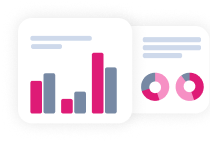Report
Audiences to watch: Gen Z
Get to know Gen Z's singletons, side hustlers, and social sharers

Jump into the trend you’re most curious about
Audiences to watch is our shiny new report, showcasing standout groups within generations that you thought you had figured out. With data from over 230,000 annual Gen Z interviews, we’re documenting their evolving story to help you spot opportunities you don’t want to miss.
There's certainly no shortage of Gen Z content out there. In fact, you're spoilt for choice. We’re bombarded with news telling us that they’re anxious about getting “brain rot”, jumping into “situationships”, and backing “body neutrality”. But how much of it is true?
We're hoping to cut through the noise, separate fact from fiction, and go deeper - exploring various subsets of this incredibly diverse generation, like digital bankers, solo travelers, and job hunters.
That way, we can give Gen Z the justice they deserve; and in turn, give brands and agencies like yours character sketches that act as springboards for further research and better marketing.
Key insights
Environmental attitudes are complicated
They still care about the planet, but not in the way you might expect. Gen Z want brands to do the heavy lifting and to be rewarded for their eco-positive behaviors.
They’re carving out new paths in the workplace
Forget climbing the corporate ladder - Gen Z are all about side hustles. Supporting them on their passion projects could be the key to employee loyalty.
They’re obsessed with connection, not just consumption
Keeping the group chat alive is an art form for Gen Z, with podcasts and video-based apps catering to this generation’s love for connection.
Goodbye restrictions, hello balance
Between 2022 and 2024, improving fitness overtook weight loss as a reason for controlling food intake. This is a nod to Gen Z’s move away from restriction.
Finances are front of mind
Gen Z are finding their financial footing. We’re able to compare 16-27 year olds now to several years ago, and it turns out they’re much savvier than previous generations at the same age.

Say hi to GWI Spark
Get reliable insights in seconds to ignite your creativity, sharpen sales pitches, and fuel your next move.
Try for free01
Smashing outdated stereotypes

Tired of the same old stereotypes? Gen Z are here to flip the script. Forget the clichés of liberal idealists or eco warriors. This generation’s rewriting the rules on sustainability, politics, and their personal lives. Let's dive in.
Eco warriors or eco opportunists?
It might be because trends like “underconsumption” are blowing up on TikTok, or because of well-known activists like Greta Thunberg; but for whatever reason, many people assume that Gen Z are more eco-conscious than the rest.
But it’s a little more complicated than that. Right now, Gen Z aren’t more likely to say they’d pay extra for an eco-friendly product than your average consumer, with their willingness to do so having dipped over time. They’re less likely to say they try to recycle than older generations too.
Gen Z’s eco efforts come with conditions
% who say they'd typically rather pay more for an eco-friendly product
- Source: GWI Core Q2 2020-Q3 2024
- Base: 946,561 consumers aged 16-27 and 3,045,747 aged 28+
Already a GWI user? Explore the data on the GWI platform
- Source: GWI Core Q2 2020-Q3 2024
- Base: 946,561 consumers aged 16-27 and 3,045,747 aged 28+
Already a GWI user? Explore the data on the GWI platform
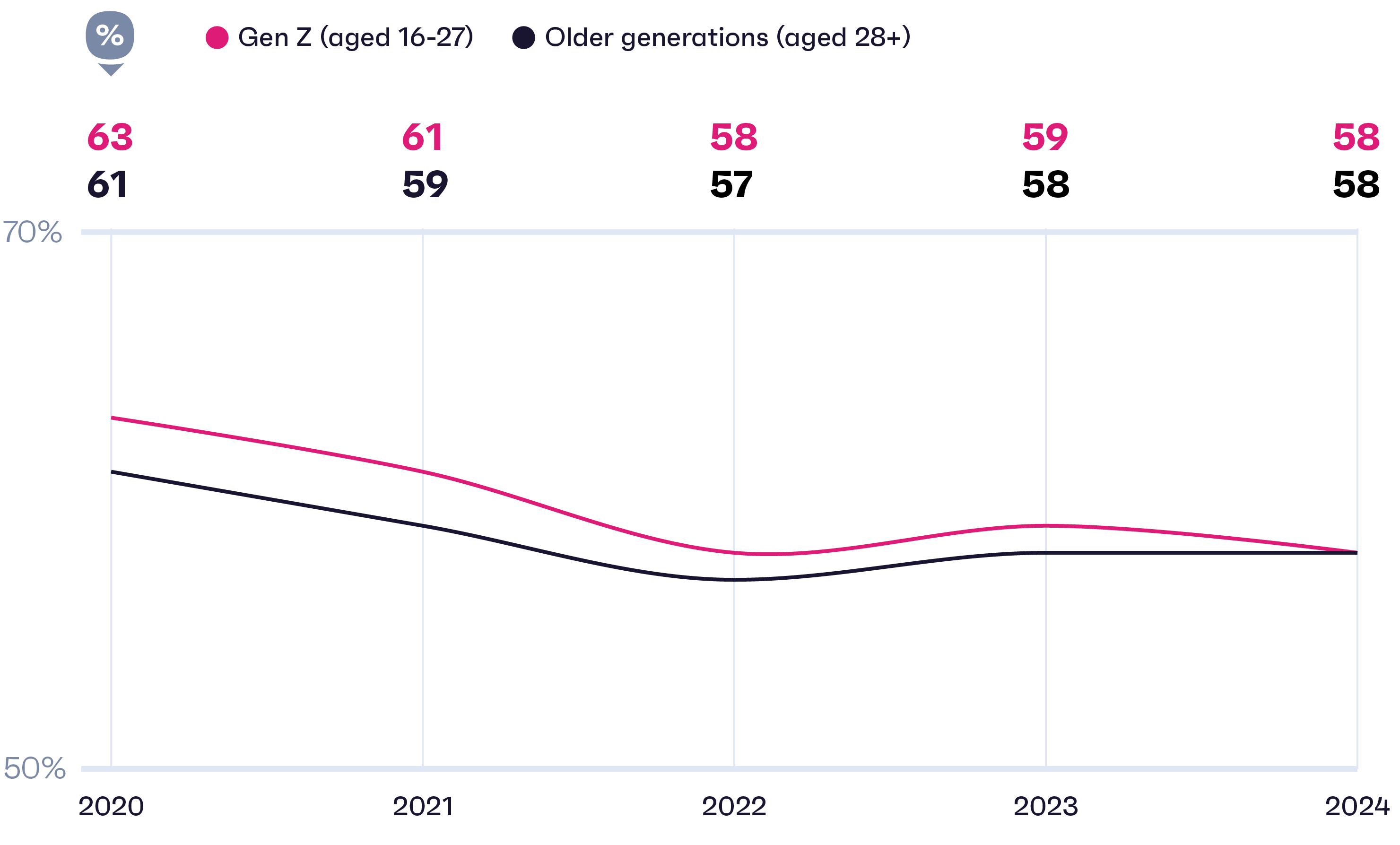
It’s not that they don’t care though; they just want brands to do the heavy lifting.

USA spotlight: More young Americans are looking to the right

Here’s another Gen Z narrative that’s been thrown around a lot, especially after the 2024 US election. They’ve got a rep for being woke, but they've also been dubbed as anti-woke. Yeah, it confused us too.
While people use the word differently, “woke” is generally understood as being liberal or big on social issues, but US Gen Z aren’t keen on it: according to our data, just 3% say it best aligns with their values.
Party lines are blurring for Gen Z
% change in the number of US Gen Z who say they'd vote for the following type of candidate if there were an election tomorrow (since 2020)

Question: If there were an election tomorrow, what type of candidate would you vote for? • Source: GWI USA Q2 2020-Q3 2024 • Base: 18,671 Americans aged 16-27
So, where on the political spectrum do they sit? Well, since 2020, there’s been a drop in the number who say they’d vote Democrat, and a consistent rise in those backing Republicans. This jump is especially noticeable among Gen Zs who care strongly about humanitarian causes, shop at discount stores, and listen to entrepreneurship podcasts. This suggests that current economic pressures and overseas conflicts are driving this shift, rather than party loyalty.
With this in mind, brands and political parties are arguably better off focusing on what Gen Z Republican and Democrat voters have in common. For example, they’re equally worried about the cost of living and likely to say learning new skills is important.
Committed to being single
We love catchy acronyms, and DINKs (dual income, no kids) is a good one. Record numbers of people are reaching 30 without kids, and of all the reasons why, personal choice is raising a lot of eyebrows.
This trend is part of a broader move toward embracing independence, from women owning their “single-girl era”, to the more radical 4B movement happening in South Korea. It’s all about rejecting traditions and creating the breathing room needed for women to do what’s best for them.
Happily ever after? Gen Z say maybe later
% of 16-27 year olds who say the following describes their relationship status
- Source: GWI Core 2014 & 2024 (averages of all waves in 2014 and 2024)
- Base: 200,205 consumers aged 16-27 in 32 markets
Already a GWI user? Explore the data on the GWI platform
- Source: GWI Core 2014 & 2024 (averages of all waves in 2014 and 2024)
- Base: 200,205 consumers aged 16-27 in 32 markets
Already a GWI user? Explore the data on the GWI platform
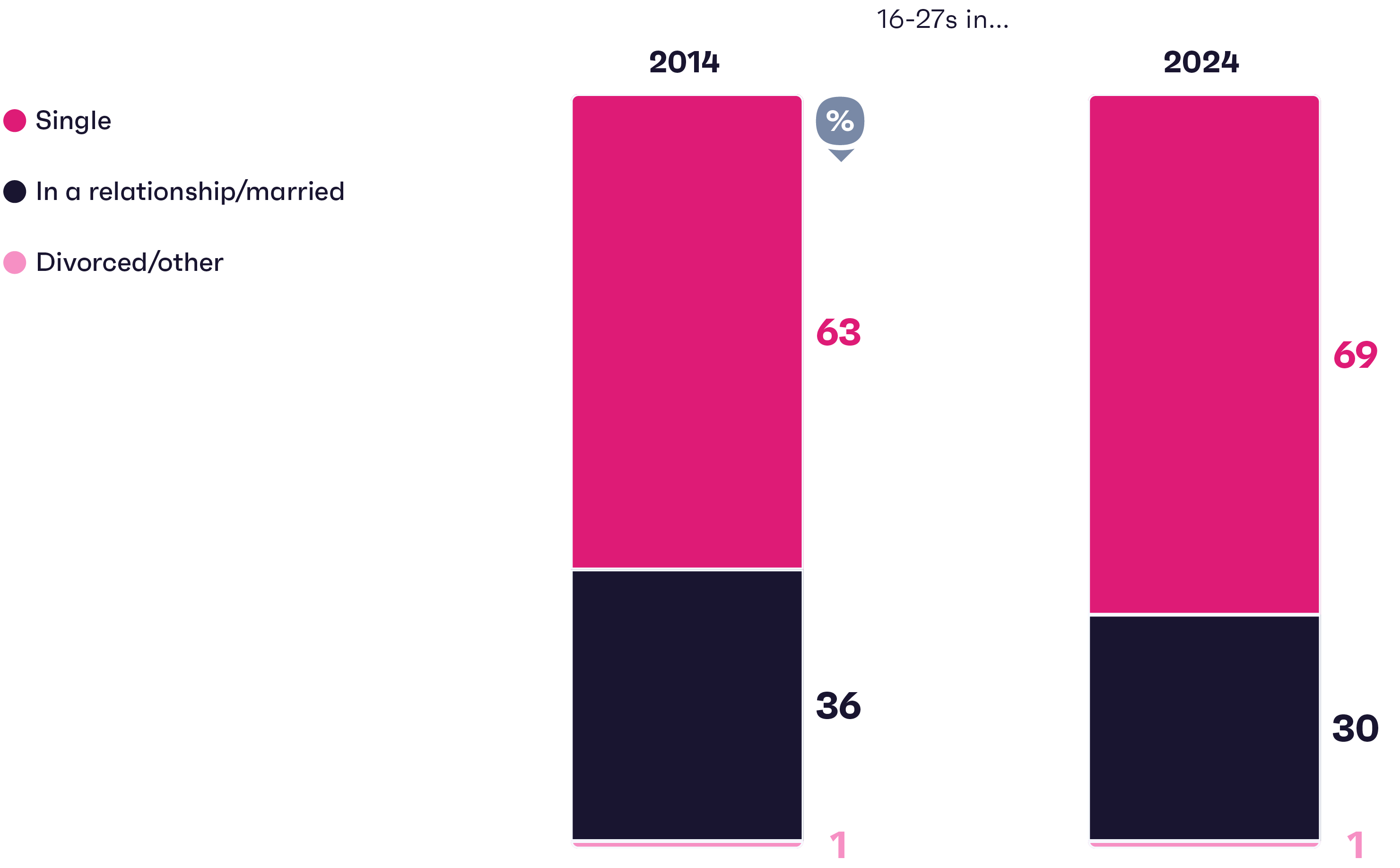
Brands should make tweaks where they can. They can support singletons and reduce the effects of the “single tax” by designing products for solo lifestyles like one-person portions, miniaturized electrical goods, and travel safety features.
Audience to watch: Solo travelers

It’s time to showcase our first unique Gen Z audience: solo travelers. Since 2023, there’s been a 16% rise in Gen Z vacationers saying that the safety of solo travelers is important when booking trips. If one thing’s clear, it’s that this group are leaving their stamp on tomorrow’s travel guide.
Here are some key things to know about them. Compared to other Gen Z vacationers, Gen Z solo travelers are more likely to…
![]() Say the ability to pay in installments matters
Say the ability to pay in installments matters
![]() Plan on taking an active holiday like surfing or climbing
Plan on taking an active holiday like surfing or climbing
![]() Research trips on online forums and message boards
Research trips on online forums and message boards
As they’re not splitting the payments, solo travelers seek flexibility. To win their loyalty, brands should offer installment options and meet them where they’re doing their pre-trip research. Bonus points for engaging in travel communities which give them confidence, especially when planning active adventures.
Solo travelers are vacationers who say they plan to or typically travel by themselves.
02
Redefining the workplace

Well, Gen Z are less loyal to their jobs, with more saying they’re on the hunt for a new one than older generations. While people move jobs more when they’re starting out, research shows that short tenures are on the rise.
Young workers are also more likely to have a side hustle, and there’s been a 34% drop in Gen Z job hunters saying opportunities for promotion matter to them since 2022, which could be taken as a sign that they’re checking out.
Gen Z are breaking up with 9-to-5
% of business professionals in each group who say they're...
- Source: GWI Work Q3 2024
- Base: 4,197 business professionals aged 16-27 and 27,233 aged 28-64 in 19 markets; 1,579 job hunters aged 16-27 and 6,963 aged 28-64
Already a GWI user? Explore the data on the GWI platform
- Source: GWI Work Q3 2024
- Base: 4,197 business professionals aged 16-27 and 27,233 aged 28-64 in 19 markets; 1,579 job hunters aged 16-27 and 6,963 aged 28-64
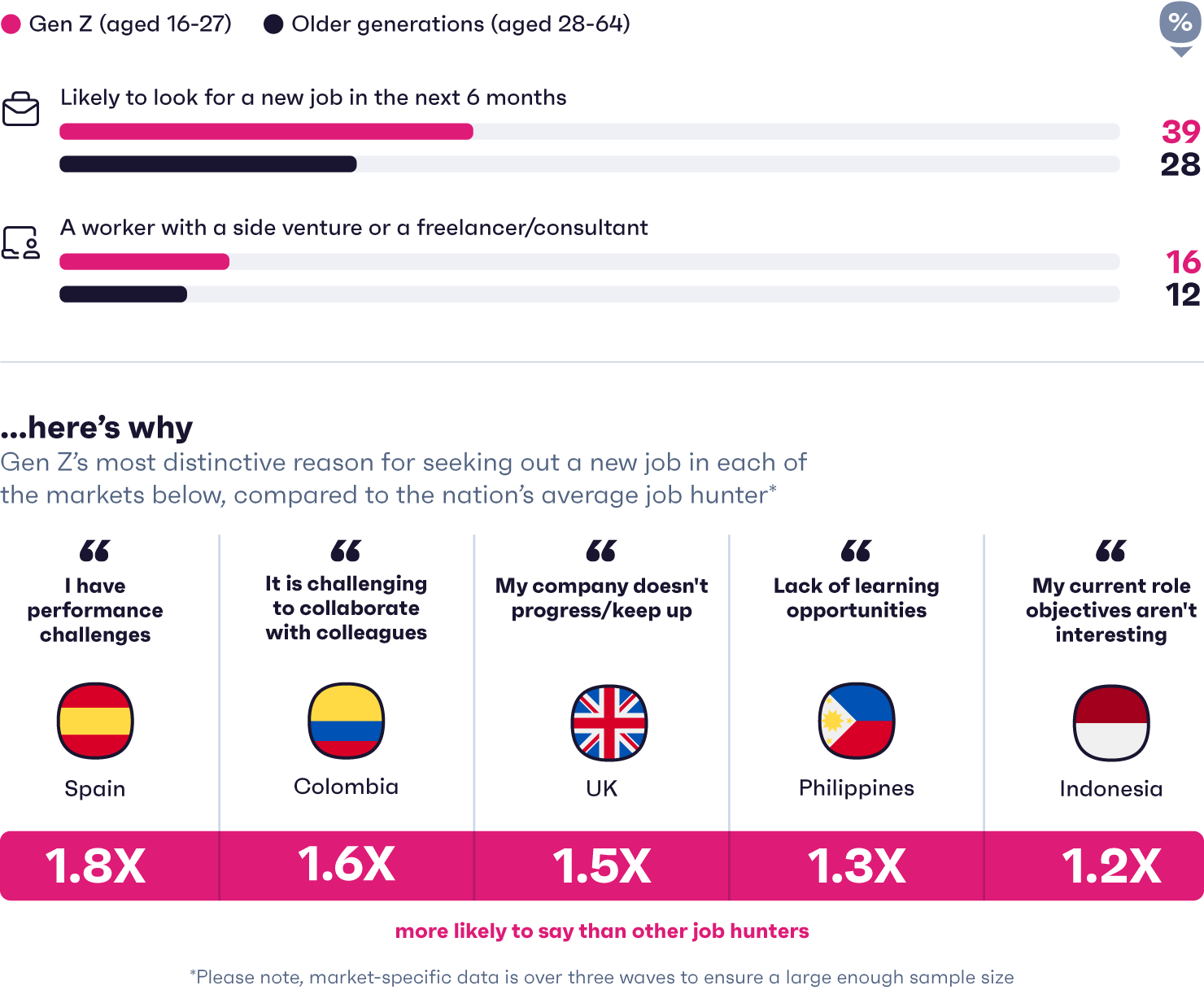
The most AI-ready, yet anxious, generation
A lack of company progress is also enough to push Gen Z to look for a new job. Retaining workers is a big challenge, and young people are sending a clear message to businesses. Adapt, or get left behind.

Innovation should be carefully handled though. Gen Z are more likely to use tools like ChatGPT than average, but they’re also less optimistic about AI’s impact on their job. They’ve been told that “AI won't take their job, somebody using AI will” and want to avoid that happening at all costs. Junior roles are seen to be the most at risk, and as businesses start baking AI into processes, anxieties could go up. So, discussion around how it gets adopted shouldn’t just be left to tech decision-makers.
Where AI fits into Gen Z's lives
Rank based on the % of Gen Z who hope AI will become more useful for the following skills in the future
- Source: GWI Zeitgeist April 2024
- Base: 2,488 consumers aged 16-27 in 12 markets
Already a GWI user? Explore the data on the GWI platform
- Source: GWI Zeitgeist April 2024
- Base: 2,488 consumers aged 16-27 in 12 markets
Already a GWI user? Explore the data on the GWI platform

Gen Z most want AI to aid problem-solving and improve productivity by taking over boring tasks, so they have more time for professional development. They’ll also appreciate companies that use AI to retrain them and support their growth. On the flip side, they’re less keen on AI being used for critical thinking or other areas they think should be left to humans.

Building on the work from home debate
Here’s an over-simplified version of the remote vs office debate as told by the media: bosses want them back in the office, while workers want to stay home.Now here’s one with a bit more depth to it. The top choice among Gen Z professionals is to work mostly remotely, but preferences are a real mixed bag. There’s less interest in being fully remote compared to 2022, and more temptation to come into the office - possibly because employees have “been there, done that” during and post-Covid.
Remote work is losing its sparkle
% change in the number of Gen Z professionals who say they'd prefer the following in terms of office attendance
- Source: GWI Work Q3 2022 & Q3 2024
- Base: 5,667 business professionals aged 16-27 who work in companies with 2+ employees/at least 1 office in 18 markets
Already a GWI user? Explore the data on the GWI platform
- Source: GWI Work Q3 2022 & Q3 2024
- Base: 5,667 business professionals aged 16-27 who work in companies with 2+ employees/at least 1 office in 18 markets
Already a GWI user? Explore the data on the GWI platform
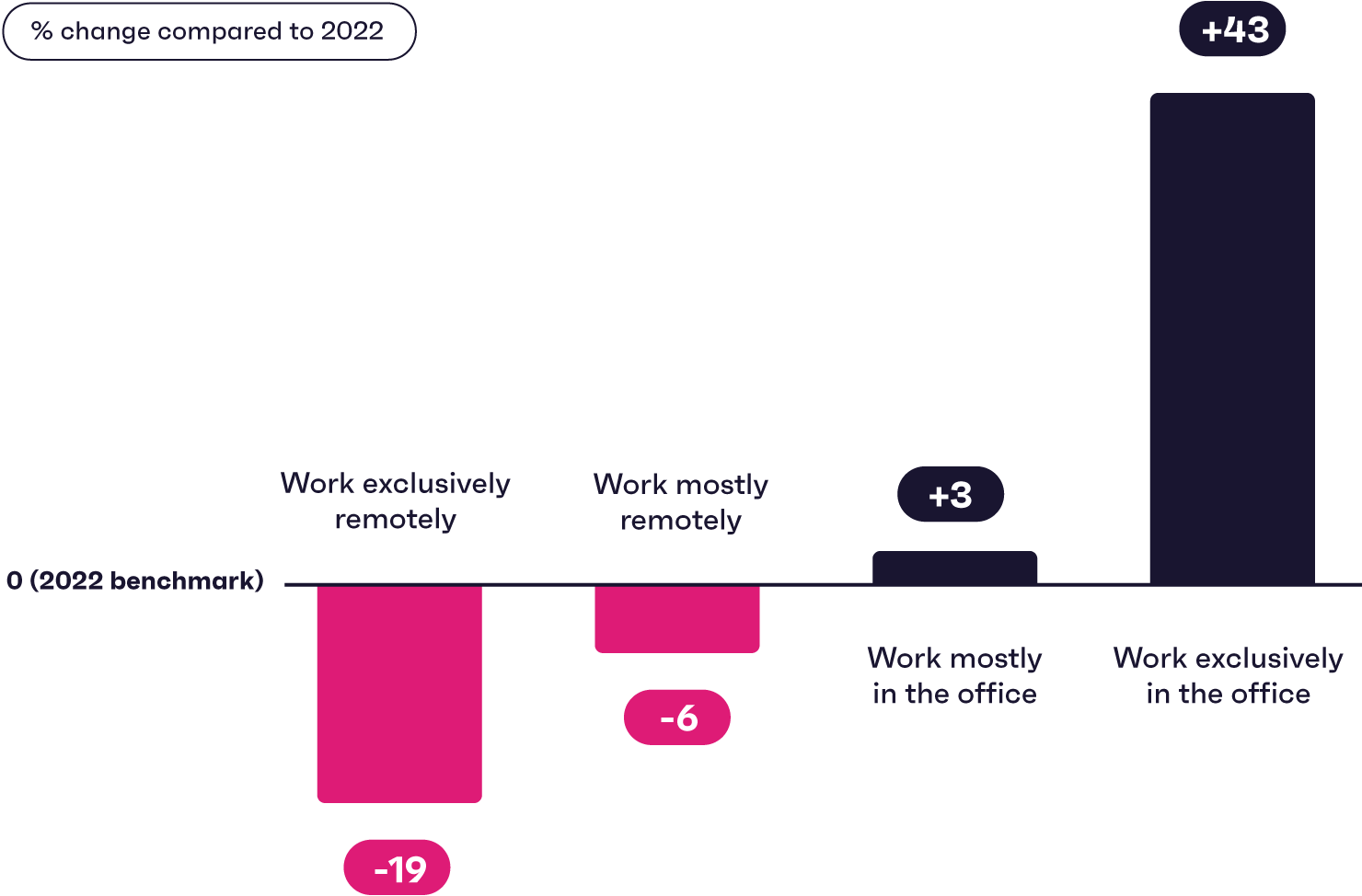
Audience to watch: Job hunters

Nearly 40% of Gen Z pros are planning their next career move right now. To keep them interested, businesses need to understand what they want - and what gives them the ick.
Compared to Gen Z non-seekers, Gen Z job hunters are… ![]() Less likely to get mental health support or development funds at work
Less likely to get mental health support or development funds at work
![]() More likely to say their company is a laggard when it comes to using tech
More likely to say their company is a laggard when it comes to using tech
![]() More likely to say teams aren’t working toward a shared vision
More likely to say teams aren’t working toward a shared vision
Gen Z job hunters don’t feel their companies are preparing themselves or their workers for the future. If they’re to stay put, they don’t just want a fair salary; they want budget to support their professional development and the freedom to make strategic decisions that make a difference.
Job hunters are professionals who say they’re likely to search for a new job in the next 6 months, while non-seekers say it’s unlikely.
03
Connecting while consuming

You’ve heard the cliché: social media is a time-draining rabbit hole, dominated by viral stars while the rest of us scroll aimlessly. We’re often told that social media gets in the way of real, meaningful connections. But Gen Z aren’t buying it (and to be honest, neither are we).
They're sharing more videos than ever and turning social apps into messaging hubs - sending memes, reacting to trends, and keeping the group chat alive.
Watch videos, send DMs, repeat
% of Gen Z Instagram/TikTok users who say they...
- Source: GWI Core Q4 2020-Q3 2024
- Base: 1,106,541 Instagram/TikTok users aged 16-27 outside China
Already a GWI user? Explore the data on the GWI platform
- Source: GWI Core Q4 2020-Q3 2024
- Base: 1,106,541 Instagram/TikTok users aged 16-27 outside China
Already a GWI user? Explore the data on the GWI platform
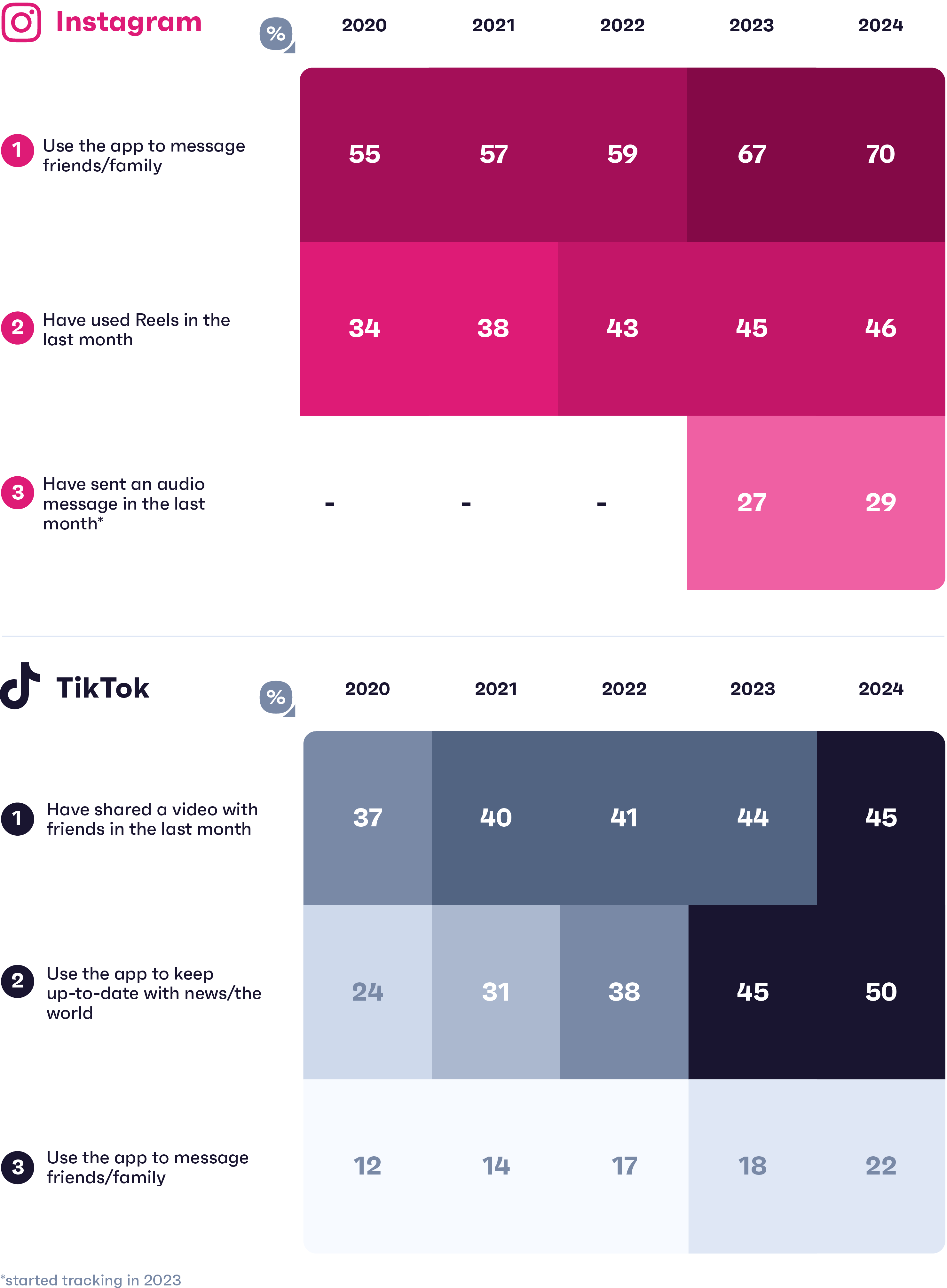
Gen Z’s scrolling feels more personal, dynamic, and layered than ever before. Video content doesn’t stifle conversation - it sparks it. And platforms are catching on. Instagram’s rolling out new features like Notes on Reels and Broadcast Channels, enhancing users' ability to engage in more interactive ways. Meanwhile, TikTok’s updated group chat feature, with space for up to 32 people, is making sure no video goes undiscussed. The conversation (and comments section) is just as important when it comes to building community.
It’s clear that this generation is all about connection, not just consumption. Many brands are actively trying to create the kind of content that’s likely to be posted in group chats by prioritizing inside jokes, common experiences among their target audience, and features encouraging participation like Instagram Stories with an “Add Yours” sticker.
Ask our customers
With 90% of 13-24 year olds using Snapchat in the US, we know Gen Z turns to the platform to stay connected with their family and friends. Whether they are still students or just starting their careers, Gen Z relies on their close circle for advice on everything from deciding if the latest pair of shoes is worth the price to short-listing their next vacation destination or following their favorite athletes. Snapchat creators also use the platform to share their day-to-day and behind the scenes - sparking conversations, engaging with followers, and building genuine connections.
Podcasts are popping off
It's not just video driving intimate chat; Gen Z now prefer listening to podcasts over other popular audio formats.Podcasts are tuning out the competition
% of Gen Z who say they prefer listening to the following types of audio content
- Source: GWI Core Q4 2020-Q3 2024
- Base: 870,646 consumers aged 16-27
Already a GWI user? Explore the data on the GWI platform
- Source: GWI Core Q4 2020-Q3 2024
- Base: 870,646 consumers aged 16-27
Already a GWI user? Explore the data on the GWI platform
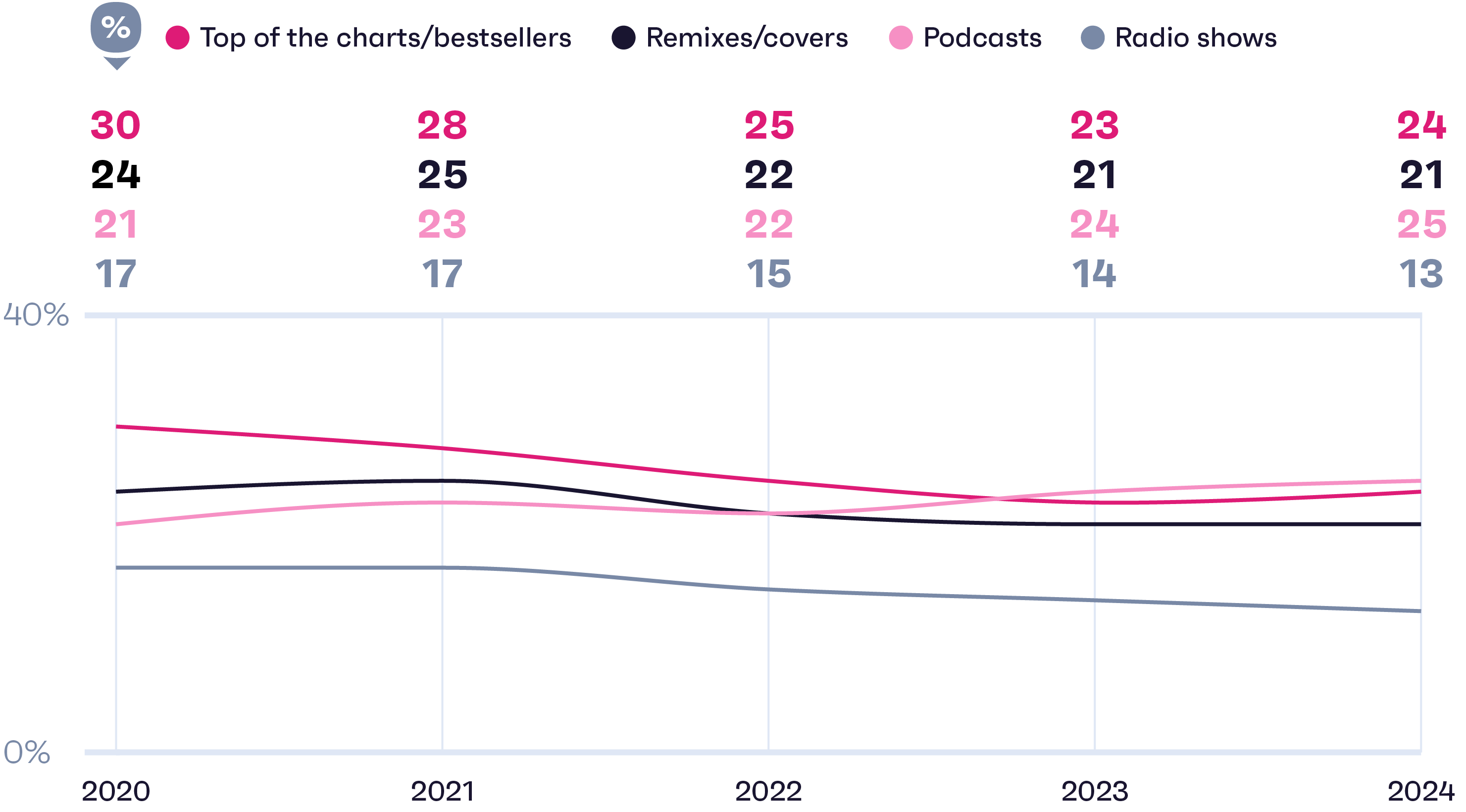
It’s easy to see why. Podcasts offer a personal, laid-back vibe that hits all the right notes for Gen Z, often leaving room for audience involvement too. Take The Girl’s Bathroom - it’s gone from a popular podcast to a series of sell-out in-person events, showing just how much this generation craves real-world discussion alongside digital content.
It won’t stop at Gen Z either; their younger siblings, Gen Alpha, are also getting into the mix.

And with video podcasts combining the best of visual content and raw conversation, this format is set to take up even more of young people’s time. We hope that brands are as tuned into this trend as their Gen Z audiences.
Audience to watch: Podcast listeners

Podcast listeners are an up-and-coming Gen Z group that’ll help companies future-proof their brand. When preparing for tomorrow though, you shouldn’t just target podcast and radio audiences the same way and hope for the best.
Compared to their radio-loving counterparts, Gen Z podcast listeners are more likely to...![]() Say they go online for study-related reasons or to find new ideas/inspo
Say they go online for study-related reasons or to find new ideas/inspo
![]() Want brands to listen to customer feedback
Want brands to listen to customer feedback
![]() Promote brands that give them the feeling of taking part or let them access exclusive content
Promote brands that give them the feeling of taking part or let them access exclusive content
Podcast fans aren’t passive listeners - they’re active, idea-driven, and engaged. To connect with this group, brands need to prioritize community building, embrace feedback, and deliver exclusive content that gets them involved.
Podcast/radio listeners are those who say they consume it for 2+ hours on a typical day.

04
Trading restriction for balance

Gen Z are rewriting the wellness rulebook, swapping strict diets and rigid routines for something more realistic.
In 2020, it was all about organic, natural foods - think green juices and eco-friendly vegan products, often showcased in perfectly curated Instagram posts by influencers. Today, high protein meals that fuel active lifestyles and fitness goals are the top priority.
High protein is the heavyweight champ
Rank based on the % of US Gen Z who say the following are very important when thinking about the food they buy
- Source: GWI USA 2020 & 2024
- Base: 16,069 Americans aged 16-27
Already a GWI user? Explore the data on the GWI platform
- Source: GWI USA 2020 & 2024
- Base: 16,069 Americans aged 16-27
Already a GWI user? Explore the data on the GWI platform

In Europe, Gen Z’s motivations around food have evolved significantly. Between Q3 2022 and Q3 2024, improving fitness overtook weight loss as a reason for controlling food intake. Meanwhile, the number of US Gen Z identifying as meat eaters with no plans to change has risen by 18% since 2020.
This speaks volumes about Gen Z’s mindset. They’re moving away from restrictive, one-size-fits-all diet trends and embracing a more practical, balanced approach.
And it’s not just in how they eat, but also how they live. Their New Year’s resolutions say it all: spending less time on social media, volunteering more, and cutting back on TV are among the resolutions that have seen the biggest jumps since this time last year. Chasing perfection is too draining, so they’re making more time for themselves and investing in feeling good.
Boosts without the baggage
They’re even trying to find a middle ground with their guilty pleasures. Non-alcoholic beer is on the rise and energy drinks are surging in popularity - but with a twist. Energy drink brands like TENZING are increasingly marketed as health drinks, with Gen Z being 18% more likely to buy similar brands like CELSIUS and PRIME than your average US energy drinker. These products appeal to Gen Z’s desire for an innocent boost.
Gen Z’s new-age guilty pleasures
% of Gen Z aged 21+ who say they drink the following monthly
- Source: GWI Core Q1 2018-Q3 2024
- Base: 619,880 consumers aged 21-27
Already a GWI user? Explore the data on the GWI platform
- Source: GWI Core Q1 2018-Q3 2024
- Base: 619,880 consumers aged 21-27
Already a GWI user? Explore the data on the GWI platform
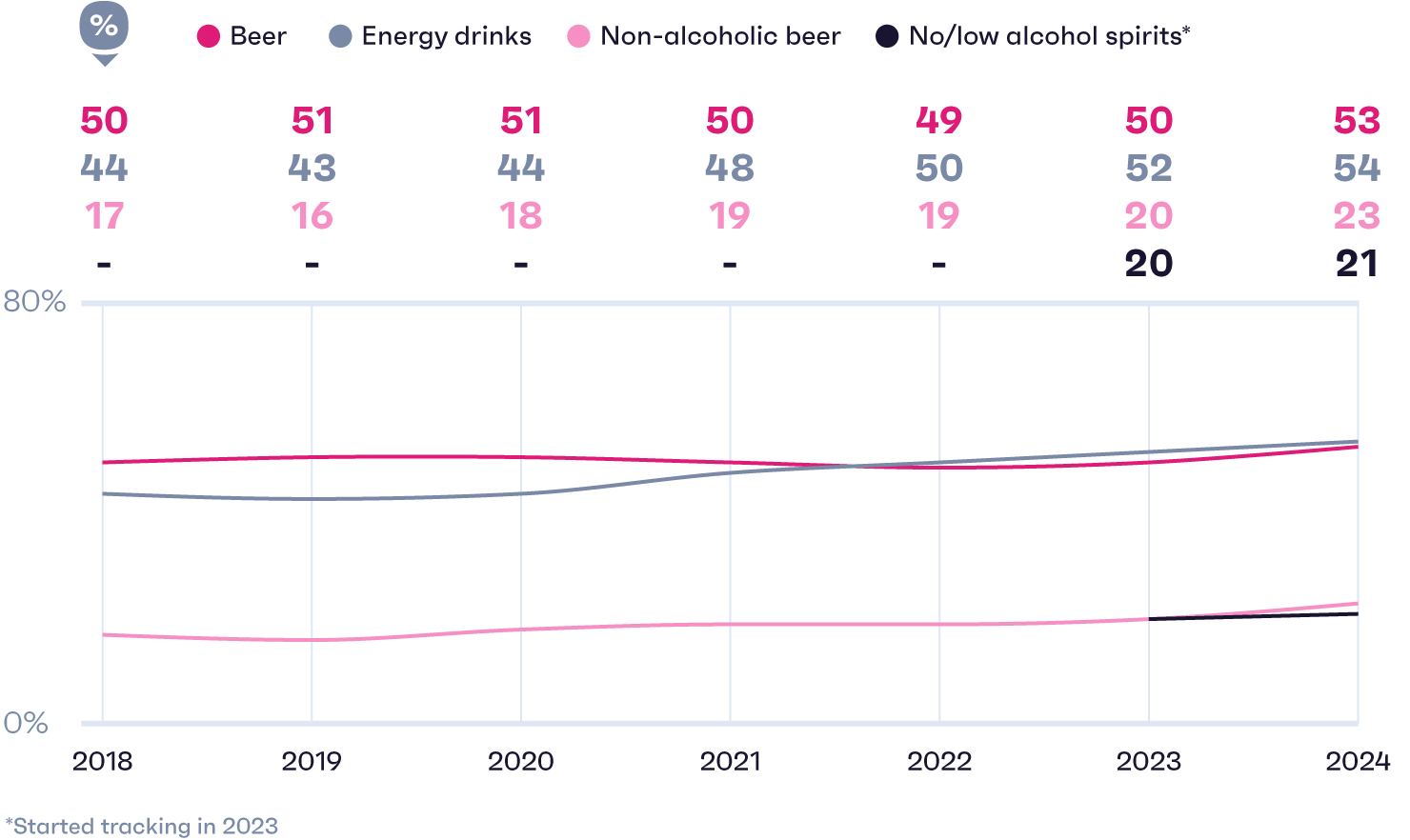
And for better or worse, vaping’s taken off. It has a big lead on smoking among 18-27 year olds in markets like Australia (where 33% vape and 20% smoke), with vapers in this age group being more likely to buy vitamins, supplements, and CBD-infused products than smokers. All this highlights demand for hybrid products that blur the line between indulgence and wellness, and do more than your traditional stimulants.
Overthinking or hyper-aware?
So why have Gen Z turned their back on restrictions? Rising health awareness plays a role. Despite experiencing fewer physical issues like muscle or joint pain, they’re actually more likely to say they feel unwell and worry about their health often, which is an attitude worth diagnosing.
Gen Z are taking their health seriously
% of US Gen Z/all Americans who say the following
- Source: GWI USA Q3 2024
- Base: 3,858 Americans aged 16-27 and 20,004 aged 16+
Already a GWI user? Explore the data on the GWI platform
- Source: GWI USA Q3 2024
- Base: 3,858 Americans aged 16-27 and 20,004 aged 16+
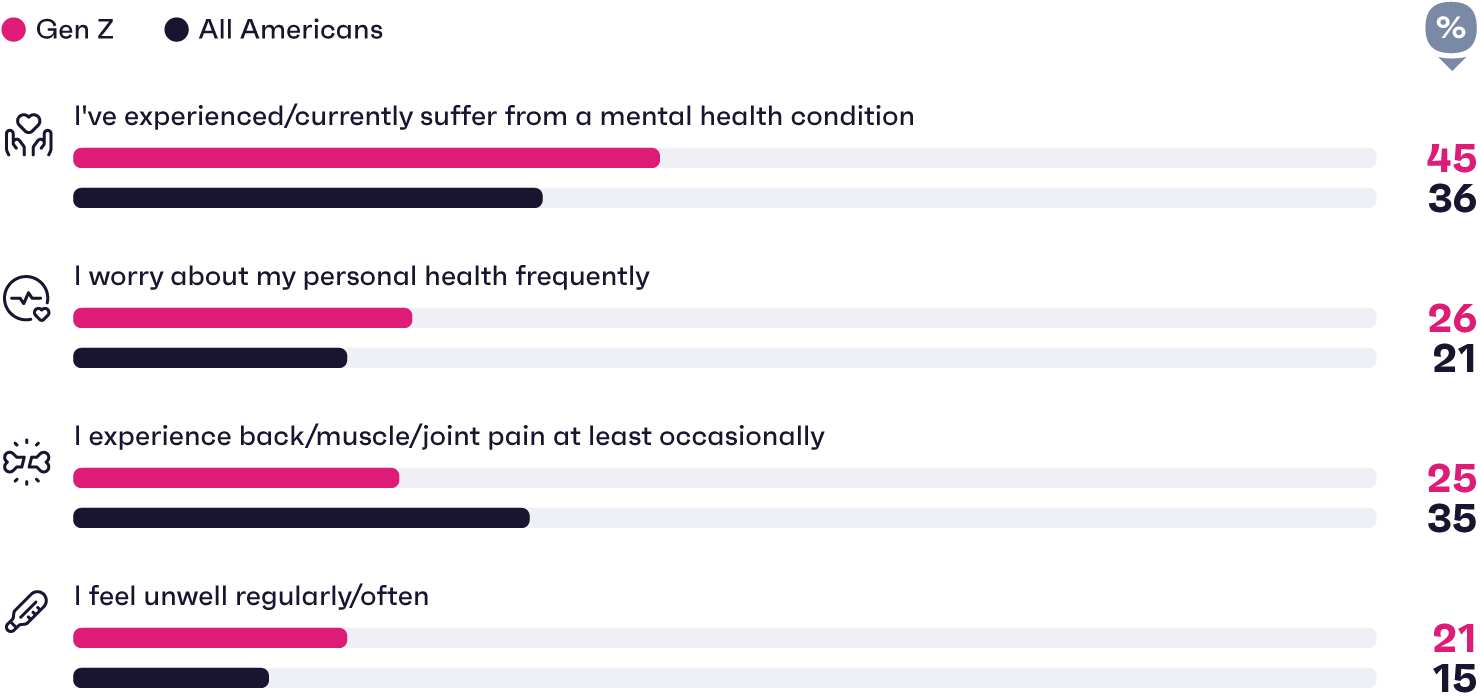

Blog
6 mental health campaigns that make a difference
We shine a light on the brands who are getting it right
Read moreSo, just because Gen Z are moving away from rigid wellness trends, it doesn’t mean their health anxieties are fading. Instead, they're trying to balance self-care with the constant stream of information and expectations placed on them.
At the end of the day, brands should recognize that Gen Z view health more holistically. To connect with this generation, they should cater to their unique set of needs and challenges - whether that takes the form of detox spots, mood-reading cars, or myth-busting health info.
Audience to watch: Flexible drinkers

And here are some industry-specific insights around their growing respect for moderation. Last year, we spotted a drop in people identifying as vegan and a rise in flexitarians, who make up a much bigger share of the plant-based market. The same is true of non-alcoholic drinks: most Gen Z who consume them also drink alcohol, in line with their “progress over perfection” way of thinking.
Compared to Gen Z teetotallers, Gen Z flexible drinkers are more likely to…![]() Eat fast food regularly, take vacations, and enjoy nights out
Eat fast food regularly, take vacations, and enjoy nights out
![]() Provide ideas for new products or designs and use branded QR codes
Provide ideas for new products or designs and use branded QR codes
![]() Follow events they’re attending on social media and discover brands via influencer endorsements
Follow events they’re attending on social media and discover brands via influencer endorsements
If you’re hoping to engage this audience, your messaging shouldn’t just be about health, as flexible drinkers enjoy their fast food and nights out too. To create standout moments, think relevant influencer collabs and consumer-led product innovations, like opportunities to vote on drinks flavors.
Flexible drinkers are those who say they drink both alcoholic and non-alcoholic drinks monthly, while teetotallers are those who don’t consume alcohol but drink non-alcoholic drinks.
05
Bootstrapped by challenger banks

Gen Z and money? It’s kind of complicated. Compared to older generations, they’re less likely to say managing finances is a top reason for using the internet, less inclined to use reward programs, and less likely to chase after the best deals. Add in temptations like buy-now-pay-later schemes and the ease of impulse buying on social media, all against a backdrop of rising student debts and unaffordable housing, and it’s easy to see why they might get a bad rap. But dig a little deeper, and you’ll uncover a much richer story - pun intended.
Finance is filling up the group chat
Rank based on the % of US/UK 16-27s who say they've talked about the following online in the last month
- Source: GWI Core Q3 2018 & Q3 2024
- Base: 11,591 US/UK consumers aged 16-27
Already a GWI user? Explore the data on the GWI platform
- Source: GWI Core Q3 2018 & Q3 2024
- Base: 11,591 US/UK consumers aged 16-27
Already a GWI user? Explore the data on the GWI platform
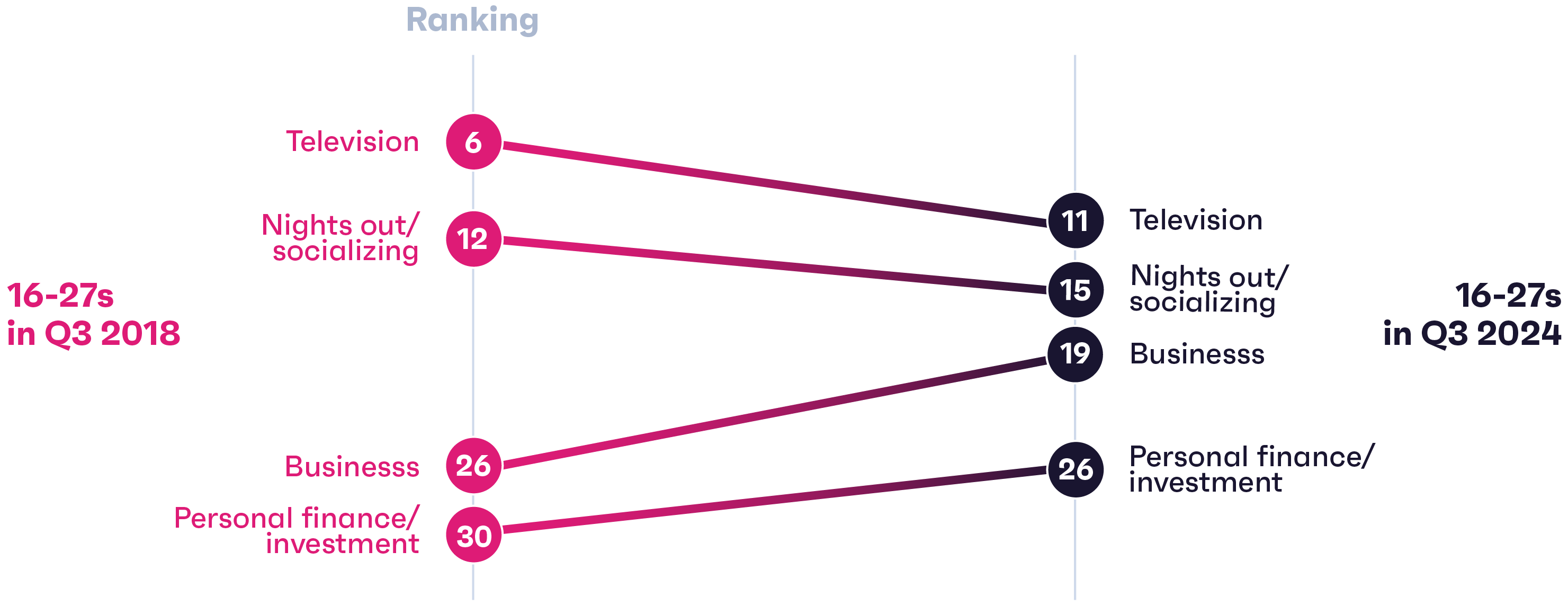
And that’s not all. Gen Z are also more at ease with credit cards and more likely to have savings or investments than millennials were at the same age.
Credit-wise, Gen Z are ahead of their time
% in each region who say...
- Source: GWI Core 2017 & 2024 (averages of all waves)
- Base: 116,794 consumers aged 18-27 in 31 markets
Already a GWI user? Explore the data on the GWI platform
- Source: GWI Core 2017 & 2024 (averages of all waves)
- Base: 116,794 consumers aged 18-27 in 31 markets
Already a GWI user? Explore the data on the GWI platform
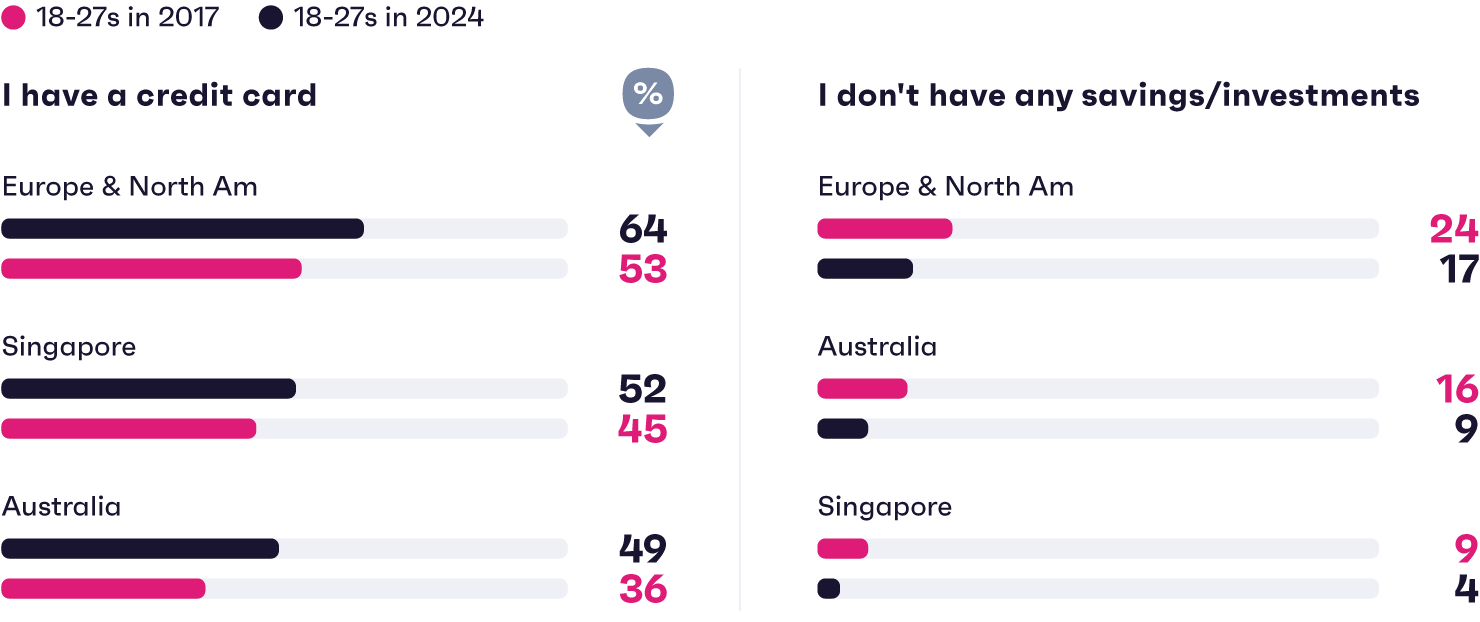
Singapore spotlight: Young investors on the rise

We’re always being told to work smarter, not harder, and young Singaporeans are taking that advice all the way to the bank. The Kiasu (fear of losing out) mindset is often linked to their money ambitions too.
Of Gen Z in 12 global markets, Singaporeans are the most likely to want banks to offer tips on saving for retirement, with many of them hoping to call quits on work before others. To get there, they’re embracing investing earlier than older generations ever did, especially in stocks, shares, and gold.
Early investing is catching on in Singapore
% in Singapore who say they have the following investments

Question: What kind of savings/investments do you have? • Source: GWI Core 2017 & 2024 (averages of all waves) • Base: 3,239 in Singapore consumers aged 18-27
Stock options make sense - there are more startups and businesses offering them. But gold may surprise you. Usually younger groups aren’t as fussed about it, leaning more toward exciting new assets; but it does have its advantages. It’s an affordable investment that can be cashed in on whenever, is thought to be less risky, and can even be bought digitally. This suggests that low-barrier options and educational content around early investing (anime-style or otherwise) will make a splash with young Singaporean investors.
Challenger banks are cracking the code
These are all promising signs, but Gen Z still needs support and guidance. It’s no surprise that they lean heavily on challenger banks and are using them more over time.
Challenger banks are shaking things up
% change in the number of UK Gen Z who say they've used the Atom, Starling, Revolut, or Monzo app in the last month (since 2020)
- Source: GWI Core Q4 2020-Q3 2024
- Base: 28,729 UK consumers aged 16-27
Already a GWI user? Explore the data on the GWI platform
- Source: GWI Core Q4 2020-Q3 2024
- Base: 28,729 UK consumers aged 16-27
Already a GWI user? Explore the data on the GWI platform
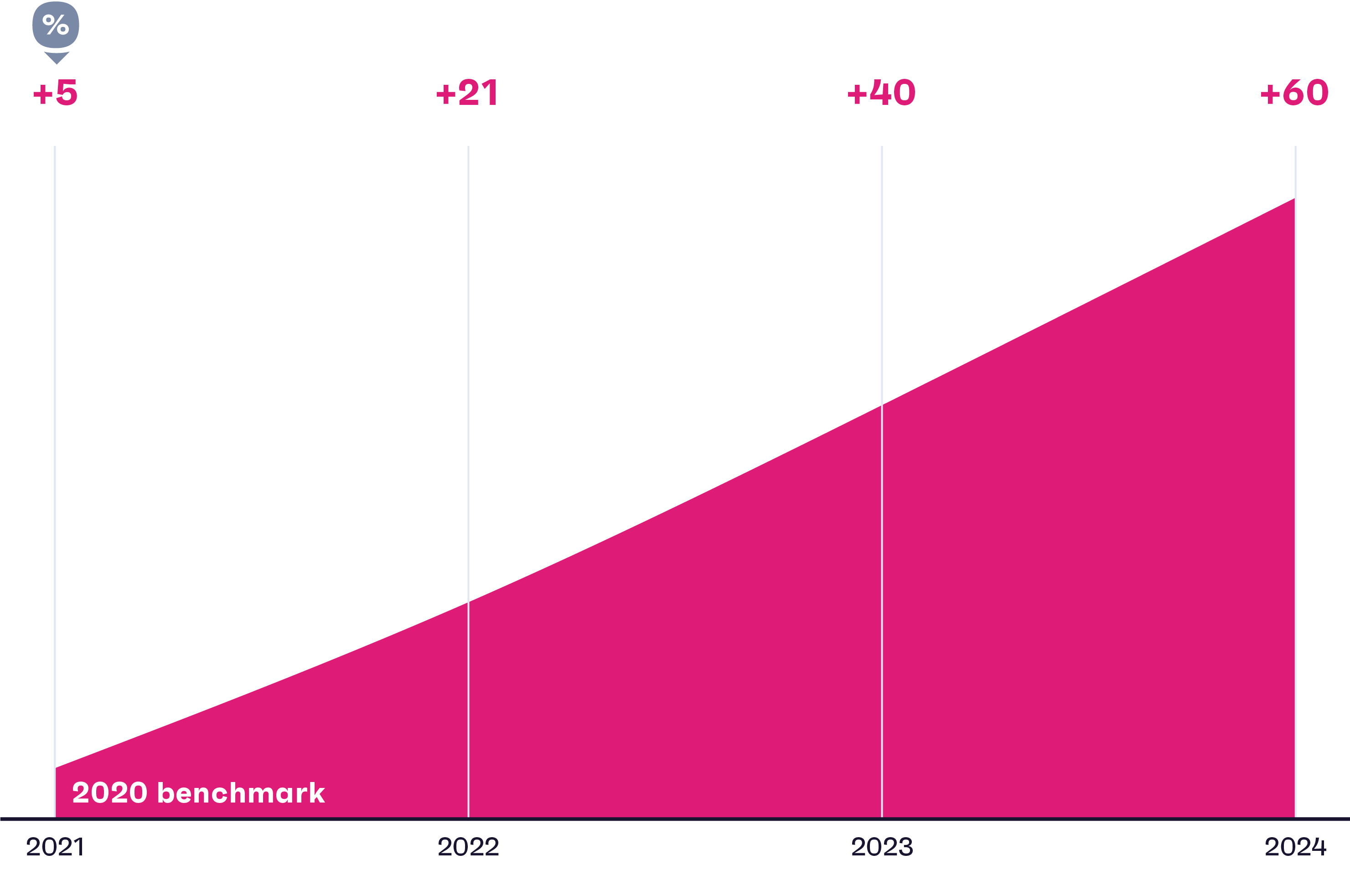
With language and solutions that feel fresh and relevant, challenger banks are filling a gap that traditional institutions often miss. They’ve cracked the code on connecting with Gen Z by offering tools that are intuitive and accessible. From gamified budgeting tools that turn saving into a win, to instant spending alerts that empower users, these innovations help Gen Z feel in control.
For traditional banks, there’s a huge opportunity to collaborate with fintechs, especially since Gen Z place a premium on innovation.

This highlights just how much room there is for banks to step up and deliver smarter, more relatable financial solutions.
Audience to watch: Digital bankers

Digital bankers aren’t only a growing audience, a fair few of them are early tech adopters - consumers who experiment with new tools and help them reach the mainstream. It’s important to understand what they want and address their feedback if banks want to earn interest on their efforts.
Gen Z digital bankers differ from traditional ones. They’re more likely to…![]() Say they’ll switch when better rates are available
Say they’ll switch when better rates are available
![]() Be planning on taking out a loan, investing in a bond, or buying stocks/shares in the next six months
Be planning on taking out a loan, investing in a bond, or buying stocks/shares in the next six months
![]() Say live-chat facilities and personalized recommendations are important when shopping around online
Say live-chat facilities and personalized recommendations are important when shopping around online
This crowd isn’t afraid to jump ship for a good deal and they love personalized experiences that make life easier. There’s a golden opportunity here for banks - serve up intuitive tools, special perks, and a dash of innovation, and you’ll win them over in no time.
Digital bankers use or are considering switching to our tracked challenger banks: Chime, Ally, N26, or BankMobile. Traditional bankers don’t use them and are planning to stick with their bank.
Closing thoughts
As Gen Z continues to evolve, so do the opportunities to connect with them. This report is just the beginning, a glimpse into the trends shaping their world. But there's a deeper story waiting to be uncovered. Whether you're aiming to support solo travelers, cater to flexible drinking habits, or attract new talent in the job market, GWI’s platform helps you uncover deeper insights to create strategies that truly drive business impact.

Say hi to GWI Spark
Get reliable insights in seconds to ignite your creativity, sharpen sales pitches, and fuel your next move.
Try for freeNotes on methodology
Each year, GWI interviews over 950,000 internet users aged 16+ in 54 markets via an online questionnaire for our Core data set. A proportion of respondents complete a shorter version of this survey via mobile, hence the sample sizes presented in the charts throughout this report may differ as some will include all respondents and others will include only respondents who completed GWI’s Core survey via PC/laptop/tablet.
When reading this report, please note that we focus on data from our ongoing global quarterly research, but also refer to our monthly Zeitgeist studies across 12 markets, our GWI USA data set, which surveys over 80,000 internet users aged 16+ in the US annually, our GWI Work data set, which surveys over 31,000 business professionals in 19 markets aged 16-64 annually, and our GWI Travel data set, which surveys over 35,000 internet users in 11 markets aged 16+ annually.




